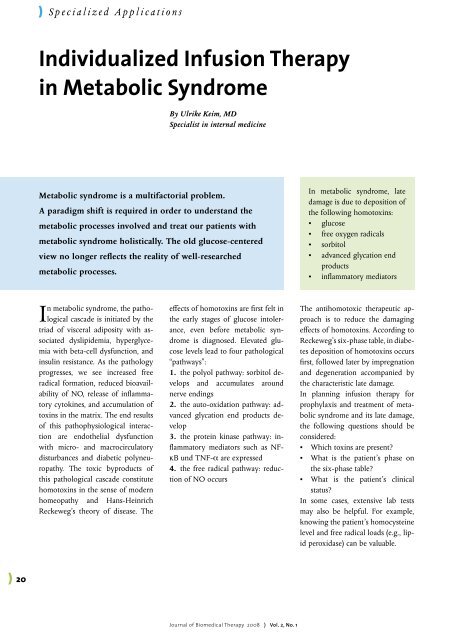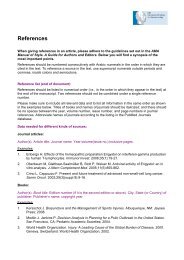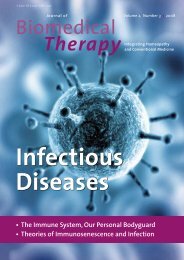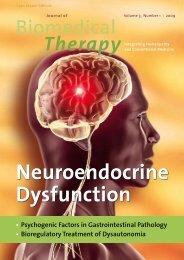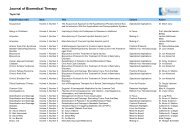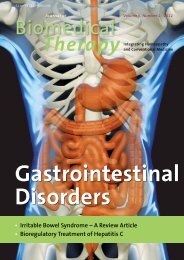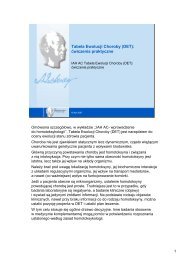Metabolic Syndrome - International Academy of Homotoxicology
Metabolic Syndrome - International Academy of Homotoxicology
Metabolic Syndrome - International Academy of Homotoxicology
Create successful ePaper yourself
Turn your PDF publications into a flip-book with our unique Google optimized e-Paper software.
) S p e c i a l i z e d A p p l i c a t i o n s<br />
Individualized Infusion Therapy<br />
in <strong>Metabolic</strong> <strong>Syndrome</strong><br />
By Ulrike Keim, MD<br />
Specialist in internal medicine<br />
<strong>Metabolic</strong> syndrome is a multifactorial problem.<br />
A paradigm shift is required in order to understand the<br />
metabolic processes involved and treat our patients with<br />
metabolic syndrome holistically. The old glucose-centered<br />
view no longer reflects the reality <strong>of</strong> well-researched<br />
metabolic processes.<br />
In metabolic syndrome, late<br />
damage is due to deposition <strong>of</strong><br />
the following homotoxins:<br />
• glucose<br />
• free oxygen radicals<br />
• sorbitol<br />
• advanced glycation end<br />
products<br />
• inflammatory mediators<br />
In metabolic syndrome, the pathological<br />
cascade is initiated by the<br />
triad <strong>of</strong> visceral adiposity with associated<br />
dyslipidemia, hyperglycemia<br />
with beta-cell dysfunction, and<br />
insulin resistance. As the pathology<br />
progresses, we see increased free<br />
radical formation, reduced bioavailability<br />
<strong>of</strong> NO, release <strong>of</strong> inflammatory<br />
cytokines, and accumulation <strong>of</strong><br />
toxins in the matrix. The end results<br />
<strong>of</strong> this pathophysiological interaction<br />
are endothelial dysfunction<br />
with micro- and macrocirculatory<br />
disturbances and diabetic polyneuropathy.<br />
The toxic byproducts <strong>of</strong><br />
this pathological cascade constitute<br />
homotoxins in the sense <strong>of</strong> modern<br />
homeopathy and Hans-Heinrich<br />
Reckeweg’s theory <strong>of</strong> disease. The<br />
effects <strong>of</strong> homotoxins are first felt in<br />
the early stages <strong>of</strong> glucose intolerance,<br />
even before metabolic syndrome<br />
is diagnosed. Elevated glucose<br />
levels lead to four pathological<br />
“pathways”:<br />
1. the polyol pathway: sorbitol develops<br />
and accumulates around<br />
nerve endings<br />
2. the auto-oxidation pathway: advanced<br />
glycation end products develop<br />
3. the protein kinase pathway: inflammatory<br />
mediators such as NFkB<br />
und TNF-α are expressed<br />
4. the free radical pathway: reduction<br />
<strong>of</strong> NO occurs<br />
The antihomotoxic therapeutic approach<br />
is to reduce the damaging<br />
effects <strong>of</strong> homotoxins. According to<br />
Reckeweg’s six-phase table, in diabetes<br />
deposition <strong>of</strong> homotoxins occurs<br />
first, followed later by impregnation<br />
and degeneration accom pa nied by<br />
the characteristic late damage.<br />
In planning infusion therapy for<br />
prophylaxis and treatment <strong>of</strong> metabolic<br />
syndrome and its late damage,<br />
the following questions should be<br />
considered:<br />
• Which toxins are present?<br />
• What is the patient’s phase on<br />
the six-phase table?<br />
• What is the patient’s clinical<br />
status?<br />
In some cases, extensive lab tests<br />
may also be helpful. For example,<br />
knowing the patient’s homocysteine<br />
level and free radical loads (e.g., lipid<br />
peroxidase) can be valuable.<br />
) 20<br />
Journal <strong>of</strong> Biomedical Therapy 2008 ) Vol. 2, No. 1


